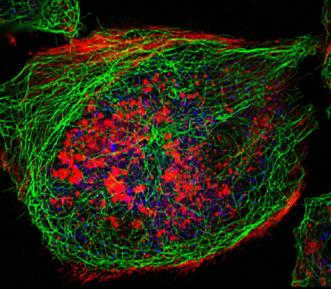
Bioinformatics and Systems Biology
Home
About Us
People
Teaching
Research
Publications
Awards
Links
Contact
Internal
The rapid progress within the areas of bioinformatics
and systems biology gives rise to numerous image analysis
problems. We collaborate with a number of researchers at
Saarland University and other research institutes in order
to address these problems.

-
Antibody Profiling for Early Cancer Diagnosis.
Recent results indicate that blood sera screening can be very useful for the early diagnosis of certain cancer types. In collaboration with the Bioinformatics Chair of Professor Hans-Peter Lenhof and the Machine Learning Group of Professor Matthias Hein, we have developped an image processing pipeline for eavluating autoantibody fingerprints in blood sera. It allows to extract fairly reliable diagnostic information for detecting different cancer types and inflammatory diseases at an early stage [1]. One example are so-called glioma, the most common primary brain tumor [2]. -
Moment Invariants for Comparing Protein Binding Sites.
In collaboration with the Computational Biology and Applied Algorithmics Group of Dr. Ingolf Sommer (Max Planck Institute for Computer Science) we have analysed the geometric shape of protein-protein binding sites by computing feature vectors of the 3D moment invariants of Mamistvalov. The similarity of these feature vectors is used as an indicator for the similarity of the binding sites. This approach has been succesfully evaluated for a representative set of the SCOPPI database consisting of 2819 binding sites. [3]. -
Denoising of 3-D Cryo-Electron Tomograms.
Cryo-Electron Tomography is a modern 3-D imaging method that allows investigations down to a biomolecular level, e.g. in order to study actin filaments and cell membranes. Unfortunately, these data sets are severely degraded by noise. In collaboration with the group of Professor Hans-Christian Hege (Zuse Institute Berlin) we have applied 3-D variants of nonlocal means filters for denoising such data sets. The data have been provided by the Max Planck Institute of Biochemistry in Martinsried near Munich. [4], [5]. -
Analysis of Particle Transport in Lung Tissue.
Understanding the particle transport in lung tissue is of importance for the study of the intake of harmful particles as well as of useful medical substances. In collaboration with the Chair of Professor Claus Michael Lehr (Dept. of Biopharmaceutics and Parmaceutical Technology) we have evaluated the usefulness of 12 different motion estimation algorithms for automising the analysis of transport phenomena in tracheal tissue. [6]. -
Intracellular Transport of Nanoparticles.
Nanoparticles are becoming more and more important in numerous applications, but their inflammatory and toxicological effects in human cells are hardly understood. In collaboration with research groups from pharmaceutical biology (Professor Alexandra Kiemer), materials science (Professors Annette Kraegeloh and Eduard Arzt) and theoretical physics (Professor Ludger Santen), an integrated approach to trace and model the intracellular transport of nanoparticles is being developped. This will allow to relate the structural properties of the nanoparticles with their subcellular distribution, and to optimise the structural properties of nanoparticles such that their inflammatory response is minimised. This project has just started and is funded by the State of Saarland.
-
A. Keller, N. Ludwig, S. Heisel, P. Leidinger, C. Andres, W.-I. Steudel,
H. Huwer, B. Burgeth, M. Hein, J. Weickert, E. Meese, H.-P. Lenhof:
Large-scale antibody profiling of human blood sera: The future of molecular diagnosis..
Informatik Spektrum, Vol. 32, No. 4, 332-338, 2009.- N. Ludwig, A. Keller, S. Heisel, P. Leidinger, V. Klein, S. Rheinheimer, C. Andres, B. Stephan, W. I. Steudel, N. Graf, B. Burgeth, J. Weickert, H.-P. Lenhof, E. Meese:
Improving seroreactivity based detection of glioma.
Neoplasia, Vol. 11, No. 12, 1383-1389, December 2009.- I. Sommer, O. Müller; F. S. Domingues, O. Sander, J. Weickert, T. Lengauer:
Moment invariants as shape recognition technique for comparing protein binding sites. Bioinformatics, Vol. 23, No. 23, 3139-3146, 2007.- M. Portz:
Denoising of a 3-D Cryo-Electron-Tomogram via Non-Local Means.
Diploma Thesis, Dept. of Computer Science, Saarland University, Saarbrücken, Germany, 2008.- D. Günther, S. Prohaska, M. Portz, H.-C. Hege, J. Weickert:
Nonlocal means filtering for reconstructing actin filaments from cryo-electron tomograms.
Preprint, 2008.- C. Kariger:
Bewegungsanalyse von Nanopartikeln im Trachealgewebe von Hühnerembryonen.
Diploma Thesis, Dept. of Computer Science, Saarland University, Saarbrücken, Germany, 2008. - N. Ludwig, A. Keller, S. Heisel, P. Leidinger, V. Klein, S. Rheinheimer, C. Andres, B. Stephan, W. I. Steudel, N. Graf, B. Burgeth, J. Weickert, H.-P. Lenhof, E. Meese:
MIA Group
©2001-2023
The author is not
responsible for
the content of
external pages.
Imprint -
Data protection